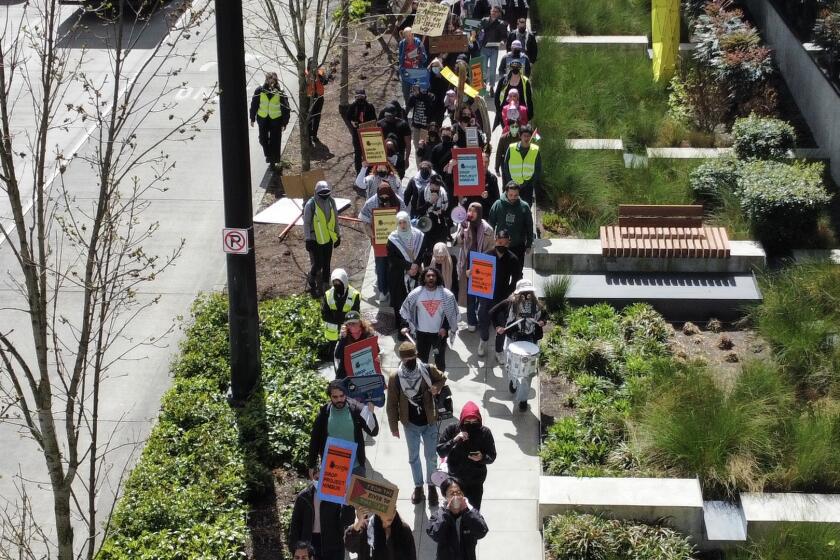A city undeterred by cooling market
It’s hard to imagine a metropolis here.
Not far from 13 pristine model homes, some with bathrooms the size of studio apartments, cows munch hay near a potholed two-lane road. There’s a stench of manure in the air.
City planners can see it: a tree-filled city-within-a-city crowded with playgrounds, business parks, lakes and shops, more than 30,000 houses on 8,200 acres of former pastureland.
If everything goes as planned, the New Model Colony will boost the population by 120,000 -- and Ontario, the first planned community in California when it was incorporated in 1891, will in 20 years be a bona fide big city.
Adrian Foley can see it too, but when the model homes open to the public for the first time today, the president of Brookfield Homes Corp.’s Southland operations will have his expectations in check.
“I’m a realist,” Foley said. “I acknowledge that the pool of buyers today doesn’t appear to be as big as it was a couple of years ago.”
In Ontario, as in the rest of Southern California, the real estate market has been taking a beating.
In March, sales of existing homes in the city were down 59% from the same month last year, according to DataQuick Information Systems. The median sale price fell to $408,000 from $425,000. (The median is the point at which half the homes sold for more and half for less.) In Edenglen, the neighborhood that Fairfax, Va.-based Brookfield Homes is developing with Irvine-based Standard Pacific Corp., prices start at $400,000 for a single-family home and go as high as $700,000.
On the other side of Riverside Drive from the New Model Colony, in the long-established Creekside development, “For Sale” signs sprout from a lot of lawns. The value of undeveloped land, much of it still home to cows, has fallen by as much as $100,000 an acre in this part of San Bernardino County in the last six months, land brokers estimate, settling way below the peak of $550,000 in 2005.
“Before, if a dairyman even hinted he wanted to sell his land, he would be inundated with offers,” said David Beno, a partner with Ontario brokerage firm Beno, Van Dyk & Owens. “Now it’s pretty hard to find someone who would close a deal.”
Brookfield’s Foley is confident that all of the 542 homes to be built at Edenglen will find buyers within five to seven years and predicts sales of about 150 to 200 homes a year. The neighborhood, with a dog park, community center, swimming pools, walking trails, rose garden and open-air movie theater, will cover 61 acres. “We envision there being a great demand for homes because of the changing face of the Inland Empire,” he said.
The Ontario City Council signed off on the New Model Colony in 1999, just as the region, which was recovering from the economic devastation of the loss of hundreds of thousands of defense-related jobs early in the decade, began to boom.
San Bernardino and Riverside counties have added about 100,000 people a year since 2001, according to Delores Conway, director of the Casden Real Estate Economics Forecast at the USC Lusk Center for Real Estate. Population growth in those counties isn’t showing signs of slowing, and jobs are being created at a fast pace.
In the Inland Empire last year, some 40,000 non-agricultural jobs were created in retail, service, transportation, construction and finance, said John Husing, an economist who specializes in analyzing that area.
The unemployment rate last year was 4.6%, the lowest Husing has seen since he began studying the area 42 years ago. The non-seasonally adjusted rate is now at 4.9%, and Husing is predicting just as healthy a job market this year as last.
But many of the new jobs won’t pay the sorts of wages necessary to buy a house in the New Model Colony. “Prices have been pushed way too high for incomes in that area,” said Christopher Thornberg, an analyst with Beacon Economics. In 2005, the last year for which he has statistics, only about 25% of the households in the Inland Empire had incomes that could support a $500,000 home.
But planners said the New Model Colony probably would end up with a target audience beyond the Inland Empire, in Los Angeles and Orange counties, where housing prices can make Ontario seem like a bargain. And with access to major freeways, including Interstates 10 and 15, Ontario is strategically located.
Mary Jane Olhasso, Ontario’s economic development director, is taking the long-term view.
“This is California,” she said. “The housing market always comes back.”
Ike Bootsma hopes so. Bootsma -- whose dairy farm fetched more than $525,000 an acre when it went on the market in 2004 -- is planning to retire in a few weeks and wants to sell 20 acres that his family has owned since 1938. They’re within the New Model Colony boundaries, and Bootsma sealed a deal with a developer in 2005 for $515,000 an acre.
When land values began to tank, the developer, who had already made a few payments, triggered a clause in the deal that allowed for a price adjustment, and asked that it move down to $375,000 an acre. Bootsma decided not to sell and now rents out the land. He figures it will be more than seven years before prices will climb to where he wants them.
In the meantime, “if the right offer comes in,” Bootsma said, “we’ll sell it anytime.”
*







